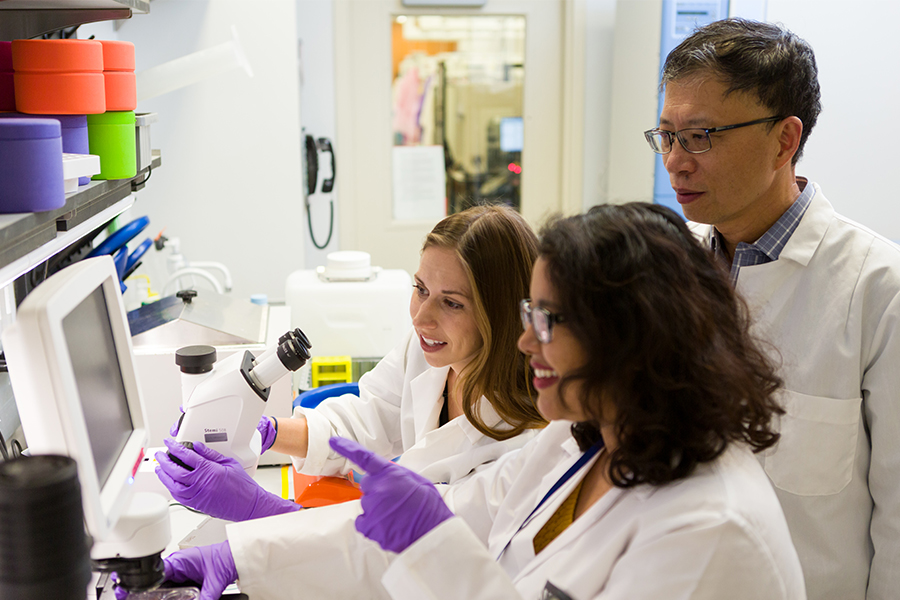NCATS Translational Science Training Program Sets Young Scientists on Paths to Career Success

Working directly with NCATS researchers, young scientists in the Division of Preclinical Innovation’s fellows program learn translational science fundamentals such as team-based collaboration and multidisciplinary research skills. (Daniel Soñé Photography)
October 13, 2020
An NCATS training program that equips young scientists with translational science skills leads to early research successes and prepares them for a broad range of science-based careers at the benchtop and beyond.
Those are the key findings from a review of fellows who completed the training program directed by NCATS’ Division of Preclinical Innovation (DPI). Researchers assessed the productivity and career outcomes of 213 fellows who completed their DPI training program from December 2011 through August 2019. The study appeared in CBE: Life Sciences Education.
“Many of our fellows are pursuing a variety of science-related career paths, including those in industry and government, as well as into academia,” said Brittany M. Haynes, Ph.D., a scientific program specialist at NCATS and corresponding author of the study. “We believe the in-depth translational science training and professional development at DPI prepare them to enter many career sectors and job functions.”
DPI immerses the fellows in translational science, teaching them the scientific and operational principles behind the process of turning research observations into medical interventions. Through a curriculum of research training, education and professional development, the fellows learn such translational science fundamentals as team-based collaboration and multidisciplinary research skills. They work directly with DPI scientists on research projects, learn to communicate and collaborate across scientific disciplines, and build individual career development plans.
“Our fellows have the opportunity to contribute to a wide array of research projects, and there’s so much expertise under one roof at DPI,” stated Jessica Faupel-Badger, Ph.D., M.P.H., Education Branch chief at NCATS. “There’s a cycle of collaboration between our groups in which fellows play an integral role. This type of collaborative opportunity for an early-career scientist is another aspect that makes the DPI training environment truly unique.”
Training program participants include short-term high school, undergraduate and graduate fellows, as well as those in longer-term postbaccalaureate and postdoctoral positions. Postbaccalaureate fellows spent an average of 1.5 years in the training program, whereas postdoctoral fellows averaged 2.5 years.
Nearly half of the training alumni (51%) were summer fellows during their DPI training, and nearly one in five alumni (19%) were in a postdoctoral position during their DPI fellowship. The remaining 30% were in postbaccalaureate or predoctoral fellowships. Approximately four in 10 alumni were female (41%).
Among the fellows’ research achievements during their time at DPI —
- Sixty-six percent of postbaccalaureate, 63% of pre- and postdoctoral, and 8% of summer alumni published their research while in the program. In addition, it is likely the fellows had more manuscripts in preparation or under review when they completed the program, Faupel-Badger noted.
- The fellows contributed to 235 publications. That number likely underestimates their productivity because it includes only the DPI fellows’ research published during their training at DPI and not post-training.
- The DPI fellows contributed to 11 patent applications and 11 inventions.
The patents and inventions, in particular, demonstrate how the DPI fellows rapidly learn to translate their research observations into real-world interventions. “These are biomedical scientists who learn to communicate their research findings to people in nonscience professions and have a direct impact on public health,” Haynes explained. “Those successes are a testament to our fellows becoming boundary crossers.”
Once the DPI training ends, the fellows’ translational science skills make them competitive candidates for multiple opportunities in the science workplace. “By learning all the steps involved in translational science, fellows develop a broader sense of what career options are available to them,” Haynes explained.
Among fellows’ career destinations after their DPI training —
- Seventy-one percent of alumni who have finished their education are in science-focused careers or research positions.
- Sixty-three percent of postbaccalaureate alumni who are continuing their education in academia are pursuing either a Ph.D. or an M.D.-Ph.D., whereas 23% are pursuing an M.D.
- Forty-three percent of the postdoctoral fellows now work for a government agency, 24% work at for-profit companies, 21% work in academia, and 10% work with nonprofit organizations.
The DPI training program continues to expand, rising to 57 fellows as of Aug. 1, 2020. That total includes 21 postbaccalaureate fellows, six predoctoral fellows and 30 postdoctoral fellows. The DPI now plans to develop surveys for its fellows before and after training, as well as for its alumni. The findings should sharpen the understanding of how DPI’s translational science training shapes fellows’ career choices, helping DPI refine its curriculum to develop translational scientists.
To learn more about translational science training opportunities, visit the NCATS Translational Science Education & Training site. For personal perspectives on the DPI fellowship initiative, learn how the training program set one summer fellow on the path to a science career, watch a postbaccalaureate fellow share her experiences in the program, and find out why one DPI postdoctoral fellow decided to become a translational sciences researcher.


